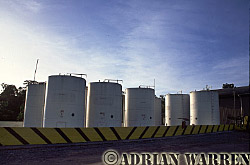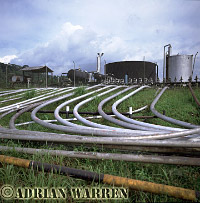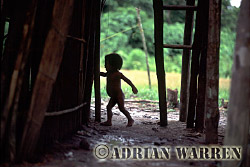WAORANI
The Saga of Ecuador's Secret People:
A Historical Perspective
© Adrian Warren, Last
Refuge Ltd., March 2002, in association with Dr. James Yost
Outside civilisation also brought pollution. There
was no protection for the Waorani against sewage from upstream colonists
or oil spillage that caused serious and toxic contamination of water supplies.
As if that was not enough, an extensive mining programme was proposed
to extract gold, uranium, vanadium, lead, zinc, copper, gypsum, clay,
sulphur, bentonite and phosphate. Although the Ecuadorian government ceded
legal right to the Waorani for some of their ancestral lands, a total
disregard of law and an all-pervading corruption erode the borders of
even that concession.

Oil installation, Waorani territory,
Ecuador, 1993
Dayuma, and a Waorani called Moi,
made separate trips to Washington as representatives of the Waorani people,
paid for by a team of lawyers from the Sierra Club Legal Defense Fund,
to file petitions on Human Rights. It was a response to the untreated
toxic waste products being dumped daily into the natural water drainage
in Waorani territory. Their journeys had begun deep in the Ecuadorian
Amazon and ended in Washington DC.. Travelling on foot, canoe, bus, train
and aeroplane, they had crossed centuries. Tucked into Moi's hand woven
palm string bag he had brought from home were his passport, toothbrush,
bird feather head dress, and a letter addressed to the President of the
United States of America. The letter invited the President to visit the
Waorani, to explain to them why the outside world was trying to destroy
them. His, and Dayuma's efforts, were in vain. They had hoped, as representatives
of their people, to be received by the President, but the closest they
came to meeting Bill Clinton was a cardboard effigy that a Polaroid photographer
had placed for tourists outside the gates of the White House

Texaco oil installation,
rio Cononaco, Ecuador, 2002 |
By 1995, encroachment
on to Waorani lands was out of control. The networks of roads had
grown, opening up some seven million hectares of Waorani territory
to speculators and colonists. As well as roads, thousands of hectares
of forest had been cut and numerous helicopter landing sites prepared.
At hundred metre intervals, explosives had been detonated to generate
sound waves for seismic analysis, before drilling started. Once the
wells were established, contamination from waste products was constant,
and discharged onto surrounding land or open pits, from where it found
its way into streams. Many streams could no longer support life, but
indigenous people had no choice but to use this water for drinking
and cooking. |
The Waorani, like many indigenous peoples, proved
to be easy to exploit. With fundamentally very different attitudes to
us they have no concept of land ownership, although they have always had
a strong sense of private ownership of goods. Their economic system is
one of generalised reciprocity - they have never had the need for a monetary
system, since the forest has always provided their basic needs and they
do not exploit it for money; and, as an egalitarian society, there are
no political leaders; family groups function independently. Outsiders
use obvious methods to make indigenous peoples more amenable to land exploitation:
gifts are offered, but they are conditional; creating dependency and community
destabilisation. They are told that they are backward, that they must
change, and embrace the more dominant culture. The results of this are
displacement, poverty, declining health, deterioration of community life
and devaluation of traditional culture. As the younger Waorani struggle
to come to terms with a new and difficult way of life, Caempaede and the
other elders are the only direct link with the old ways.

Waorani Indian boy, rio Cononaco,
Ecuador, 1993
|
